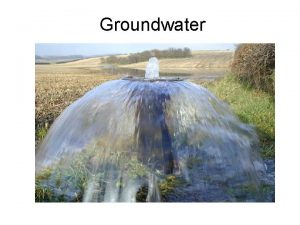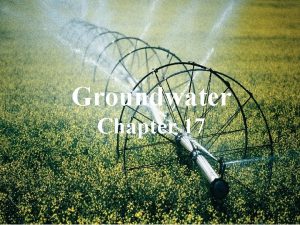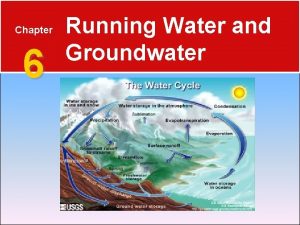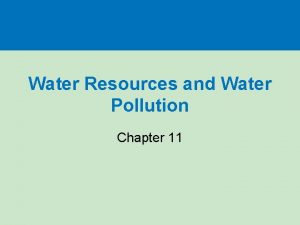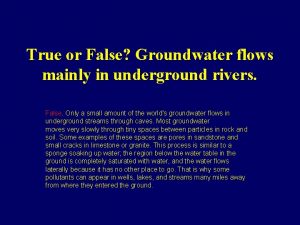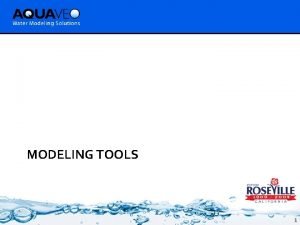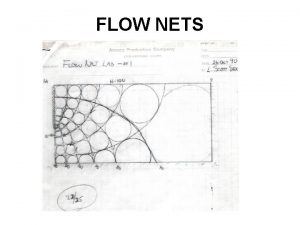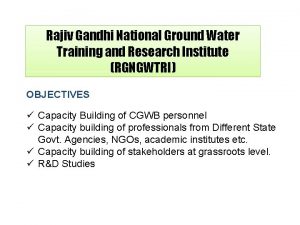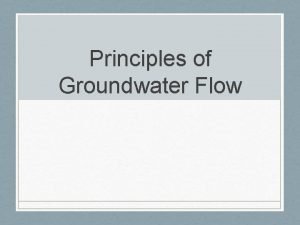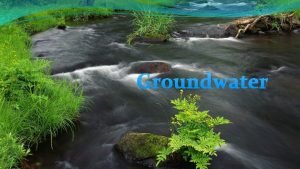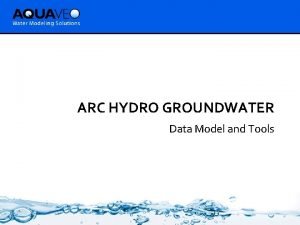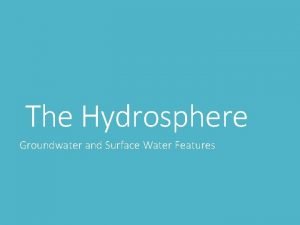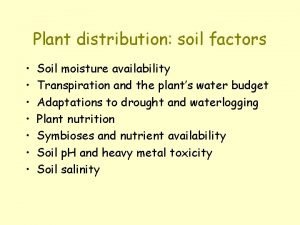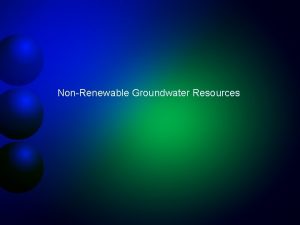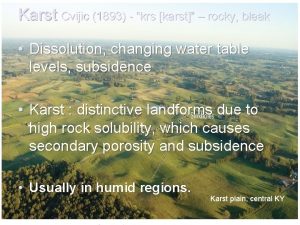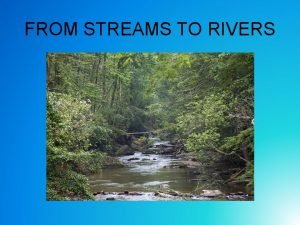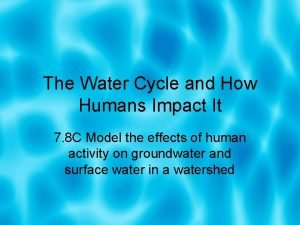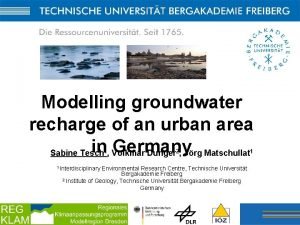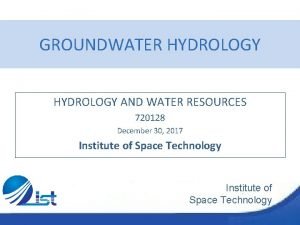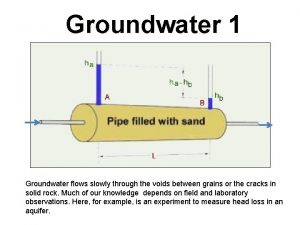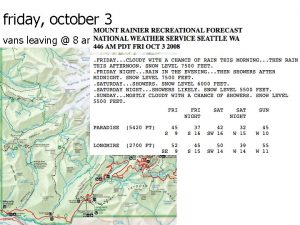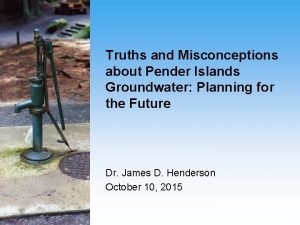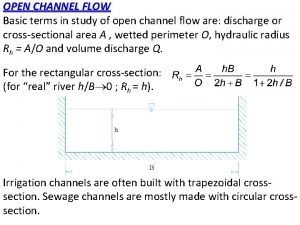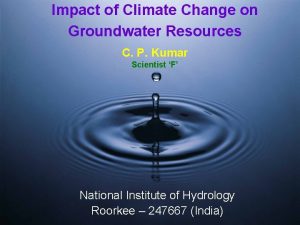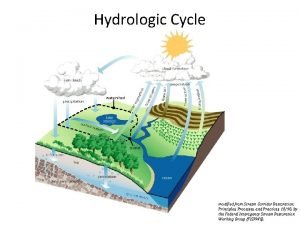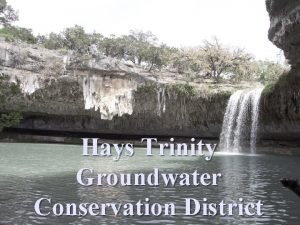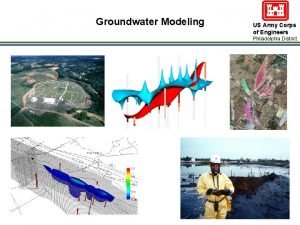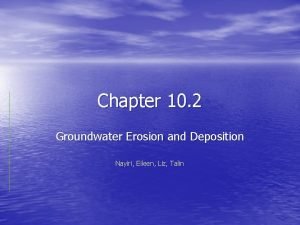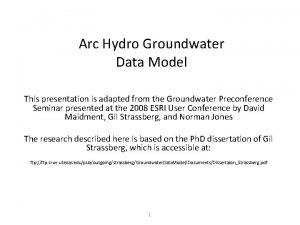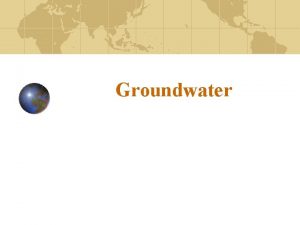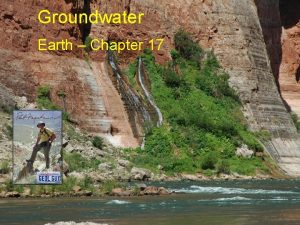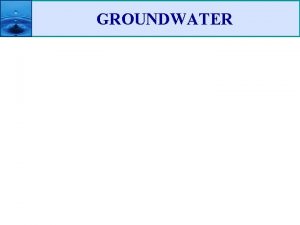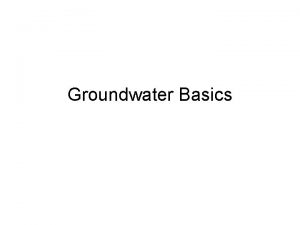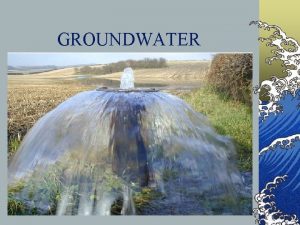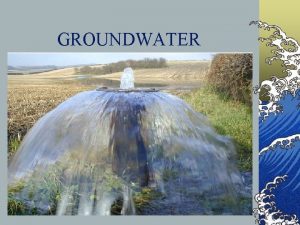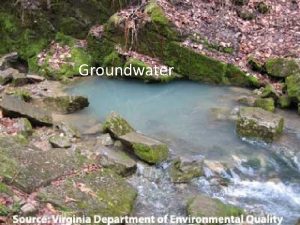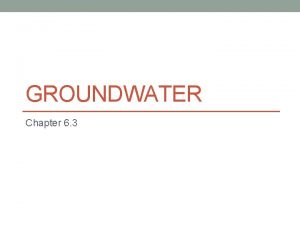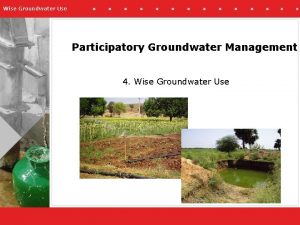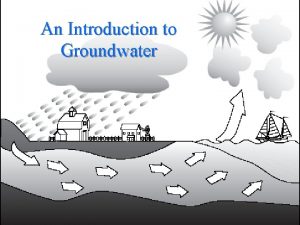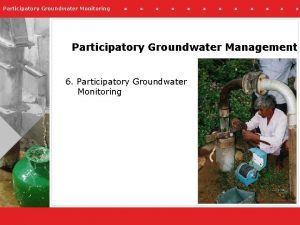Groundwater Chapter 11 Importance of groundwater Groundwater is

















































- Slides: 49

Groundwater Chapter 11

Importance of groundwater Groundwater is water found in sediment, plus narrow fractures in bedrock Groundwater is the largest reservoir of fresh water available to humans

Distribution of Groundwater

Fresh water of the Hydrosphere

The water table Water table is the upper limit of saturation Variations in the water table • Depth is highly variable – Varies seasonally and from year to year • Shape is usually similar to surface topography

Question: If you had to drill a water well in Colorado, where would you do it the least expensively? Deeper holes cost more money. A) In granite in the Mountains on a ridgetop B) In granite halfway between Boulder Creek and the nearest ridgetop C) In the plains near the Platte river, a region underlain by sandstone at shallow depths. D) Nowhere, since groundwater does not exist in Colorado.

Factors influencing movement of groundwater Permeability, aquitards, and aquifers • Permeability – the ability of a material to transmit a fluid • Aquitard – an impermeable layer that hinders water movement (such as clay) • Aquifer – permeable rock strata or sediment that transmits groundwater freely (such as sands and gravels)

Springs may result from a perched water table


Features associated with groundwater Hot springs • Water is 6 -9 o. C warmer than the mean annual air temperature of the locality • The water for most hot springs is heated by cooling of igneous rock

Distribution of hot springs and geysers in the United States

Glenwood Hot Springs

Mt Princeton Hot Springs

Why are the springs at Mount Princeton hot? A) Water runs up a fault zone from great depth B) Mining operations in nearby Leadville have changed the groundwater system in Colorado C) A dormant volcano lies under this part of the state and heats the water there D) Global warming is causing springs to heat up around the world

Features associated with groundwater Geysers • Intermittent hot springs • Water erupts with great force • Occur where extensive underground chambers exist within hot igneous rock • Groundwater heats, expands, changes to steam, and erupts

Evolution of a geyser eruption

Old Faithful geyser in Yellowstone Natl Park

Yellowstone Geyser erupting

Yellowstone Geyser Pool prior to eruption

Aquifer Model for the Front Range

Location of Ogallala Aquifer

Question: How many gallons of groundwater are pumped from aquifers per day in the USA? A) B) C) D) 100 Million 1 Billion 10 Billion D) 100 Billion

Question: How many gallons of groundwater are pumped from aquifers per day in the USA? A) B) C) D) 100 Million 1 Billion 10 Billion D) 100 Billion

Features associated with groundwater Wells • To ensure a continuous supply of water, a well must penetrate below the water table • Pumping of wells can cause – Drawdown (lowering) of the water table – Cone of depression in the water table

Formation of a cone of depression in the water table

Problems associated with groundwater withdrawal Treating groundwater as a nonrenewable resource • In many places water available to recharge aquifer is less than amount being withdrawn Subsidence • Ground sinks when water is pumped from wells faster than natural recharge replaces it

How many years does it take to effectively remove groundwater resources in the Great Plains? A) B) C) D) A few years Tens of years Hundreds of years Thousands of years

How many years does it take to effectively remove groundwater resources in the Great Plains? A) B) C) D) A few years Tens of years Hundreds of years Thousands of years

Problems associated with groundwater withdrawal Saltwater contamination • Groundwater withdrawal causes saltwater to be drawn into wells, contaminating supply • Primarily a problem in coastal areas

Saltwater contamination due to excessive well pumping


Groundwater contamination Common source is sewage • Extremely permeable aquifers, such as gravel, have such large pores that groundwater may travel long distances without being cleaned • Sewage usually becomes purified as it passes through a few dozen meters of an aquifer composed of sand or permeable sandstone

Contamination of water well by Septic System

Question: Why is ground water flow direction changing direction here? A) Pumping lowers water table so that it is tilted B) towards community well B) Bacteria expand push water C) away from septic tank C) Drought causes water table D) to become lower D) Septic wastes always flow E) towards wells open to the air

Fast flow contaminates well

Why are septic systems usually only used in rural areas? A) It makes for better lyrics in country and western songs B) Few people live in these areas and the septic systems can handle the small amounts of waste that is produced C) Sewer pipes in cities block the flow of groundwater and render septic systems ineffective D) Its expensive to run sewer pipes over large areas for only a few houses E) B and D

Hydraulic head and urban water supplies

Why are there no water tanks in Boulder? A) Boulder gets its water from the mountains, so there is already lots of hydraulic head B) Boulder disguises its water tanks as large rocks in the Flatirons C) Boulder doesn’t use enough water to require the use of tanks D) People in Boulder only drink Evian and therefore don’t use tap water

Geologic work of groundwater Caverns • Most caverns are created by acidic groundwater dissolving soluble rock at or just below the surface in the zone of saturation

Geologic work of groundwater Groundwater dissolves rock • Groundwater is often mildly acidic – Contains weak carbonic acid – Forms when rainwater dissolves carbon dioxide from the air and from decaying plants • Carbonic acid reacts with calcite in limestone to form calcium bicarbonate, a soluble material

Geologic work of groundwater Caverns • Features found within caverns – Composed of dripstone (travertine) – Calcite deposited as dripping water evaporates – Collectively, they are called speleothems – Includes stalactites (hanging from the ceiling) and stalagmites (form on the floor of a cavern)

Speleothems in Carlsbad Caverns National Park

“Soda straws” in Carlsbad Caverns National Park

Geologic work of groundwater Karst topography • Landscapes that have been shaped by the dissolving power of groundwater • Some common features include – Irregular terrain – Sinkhole or sinks (formed by groundwater slowly dissolving the bedrock often accompanied by collapse) – Striking lack of surface drainage (streams)

Stream incision, cave development and karst topography

Development of a Sinkhole

Sinkholes in Florida

Sinkholes in Urban Settings

End of Chapter 11
 Uses of surface water
Uses of surface water What is importance of groundwater
What is importance of groundwater Chapter 6 running water and groundwater
Chapter 6 running water and groundwater Source of contamination
Source of contamination Measures to reduce water pollution
Measures to reduce water pollution True or false: groundwater can flow.
True or false: groundwater can flow. Running water and groundwater
Running water and groundwater Njdep gwqs
Njdep gwqs Gms groundwater
Gms groundwater Groundwater assessment methodology
Groundwater assessment methodology Water table
Water table Septic tank contamination groundwater
Septic tank contamination groundwater Groundwater flow net
Groundwater flow net Water erosion and deposition
Water erosion and deposition Brain pop water cycle
Brain pop water cycle Rgngwtri
Rgngwtri Hydraulic head
Hydraulic head Permeability in rocks
Permeability in rocks Arc hydro groundwater
Arc hydro groundwater Water permeable
Water permeable Groundwater table
Groundwater table Is groundwater renewable or nonrenewable
Is groundwater renewable or nonrenewable Caves and karst topography webquest answer key
Caves and karst topography webquest answer key How does groundwater rejoin the water cycle
How does groundwater rejoin the water cycle Human impact on groundwater
Human impact on groundwater Groundwater
Groundwater Infiltration definition geography
Infiltration definition geography Groundwater system
Groundwater system Groundwater recharge
Groundwater recharge Groundwater
Groundwater Darcy law
Darcy law Base level diagram
Base level diagram Groundwater recharge pdf
Groundwater recharge pdf Groundwater
Groundwater Groundwater flow definition
Groundwater flow definition Iot iran
Iot iran Groundwater mining
Groundwater mining Water budget equation
Water budget equation Hays trinity groundwater conservation district
Hays trinity groundwater conservation district Army corps of engineers philadelphia
Army corps of engineers philadelphia Groundwater information network
Groundwater information network Groundwater erosion and deposition
Groundwater erosion and deposition Arc hydro groundwater
Arc hydro groundwater Arc hydro groundwater
Arc hydro groundwater Simon chapter 8 lord of the flies
Simon chapter 8 lord of the flies Lesson 1 the importance of nutrition
Lesson 1 the importance of nutrition Literature review
Literature review Nature of the study examples
Nature of the study examples Objectives in work immersion
Objectives in work immersion Weather instrument
Weather instrument
